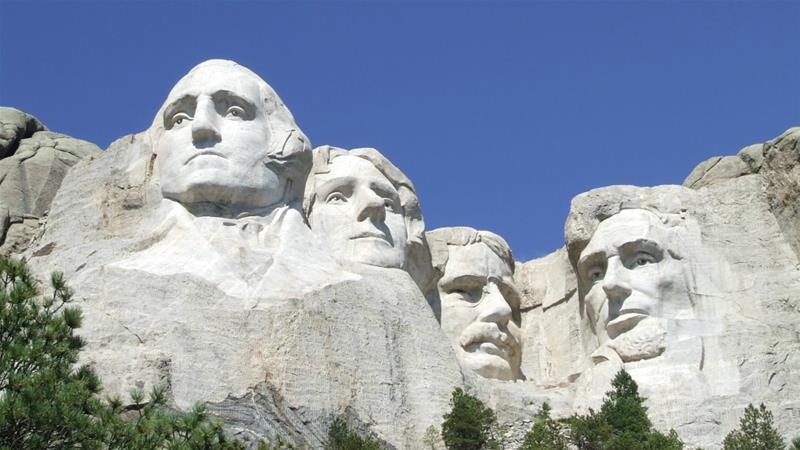Controversy at Mount Rushmore
Why the Monument Should Not be Torn Down
Photo Courtesy of Aljazeera News Site
Activist push for the removal of the monument Mount Rushmore,in South Dakota
October 27, 2020
Prompted by recent protests and spikes in activism, the debate on tearing down American monuments has seen renewed interest, in particular, the Mount Rushmore monument. The local Native American tribe, the Sioux tribe, along with others, have been protesting in an effort to get higher officials, such as governor of South Dakoda, to tear the great monument down from the mountainside.
The Sioux tribe claims that the area is sacred and the monument is disrespectful to their culture and land. Others argue that the monument does not hold any significant value and glorifies flawed U.S. figures: “…Mount Rushmore does not mean anything significant,” Saugus student, Ryan Alkihanian said.
In 1868, the Native Americans and the U.S. government signed a treaty called the Treaty of Fort Laramie. This treaty protected the Sioux people and promised that the region of the Black Hills to be undisturbed. However, mining became a huge industry in the midwest and miners had moved into the region. The Sioux people expressed their feelings of betrayal from having their treaty discarded, often leading to violent clashes between pioneers and Native Americans.
The U.S. continued to disturb the sacred land until it became a national park in 1933, being protected by the government. To this day, the Sioux people protest the disruption of their land, including Mt. Rushmore, which is carved into a mountain in the sacred region of the Sioux.
A sculptor by the name of Gutzon Borglum was hired to start the project by Doane Robinson. Borglum was a Danish sculptor and believed heavily in celebrating U.S. nationalism. He agreed to come onto the project and discussed the significance of who’s heads would be carved.
The heads of George Washington and Abraham Lincoln were chosen for national significance. Thomas Jefferson and Theodore Rosevelt were chosen for recognition of their contributions to the birth of the country and its growth.
According to History.com, “Sioux activists called for the monument to be taken down, even as they continue to protest what they view as illegal U.S. possession of their ancestral lands.” Borglum later went to the government and got the project legally checked and funded.
Alkihanian later said, “The monument should not be taken down but changed. As our country has grown, so have the beliefs of our people.”
In the midst of construction, Borglum designed a room inside the heads called the U.S. Hall of Records. Unfortunately, he died before the completion of the monument, but the Hall of Records would house U.S. artifacts and documents, as well as descriptions of their meanings.
“Each succeeding civilization forgets his predecessor,” said Borglum. His mission was to make sure that U.S. history would not be forgotten.
Borglum also wrote, “Into this room the records of what our people aspired to and what they accomplished should be collected, and on the walls of this room should be cut the literal record of conception of our republic; its successful creation; the record of its westward movement to the Pacific; its presidents; how the memorial was built, and, frankly, why.”
The room where the Hall of Records was supposed to be is now just a large room with dynamite holes in the wall. It’s covered up now, due to the safety danger it would bring to tourists. But it still resides in the mountain, behind the Presidents’ heads.
Today, the Sioux people are still seeking to tear down the monument. Saugus student Joana George said, “O.J. Semans made a suggestion that I personally think is best: rather than taking down the monument, we should rather convert the tourist space into an educational one, where we can teach visitors about Native American history and their interaction with this monument.”
With this type of a peaceful idea, the monument can teach of the trials and tribulations the Native Americans went through both before and during the construction of the monument. It can also help keep the monument and contribute to the Sioux people.
The Sioux people’s rightful land was, indeed, discarded from the original treaty, but, now, the land is protected as a national park by the government. The monument is a true representation of the American people, no matter what race or nationality.
“It belongs to both the Sioux peoples of the reservation, as well as to the American peoples.” George said. Mount Rushmore was built on the foundation and hope that the United States brings to us. Let the people of this country never forget how we got here and who we are as a country.
The opinions in The Scroll’s editorials are strictly the views of the writers of the staff or outside submissions. The views do not represent or reflect the opinions or policies of Saugus High School or the William S. Hart School District. The Scroll welcomes all reactions and outside submissions to share alternative views.

